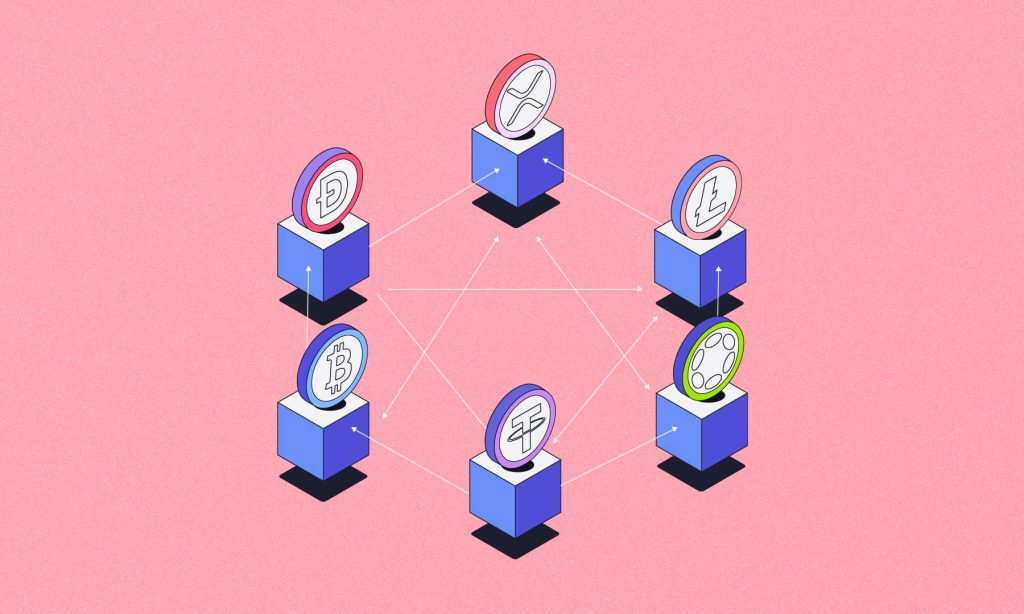What is a DEX (Decentralized Exchange)?
Individuals can exchange crypto in an accessible setting on a DEX (decentralized exchange), which is a peer-to-peer marketplace. This eliminates the need for an intermediary to handle the transfer and custody of the money. DEXs, which use blockchain-based contracts, allow the exchange of assets, replacing intermediaries, brokers, banks, payment processors, and other entities.
DEXs offer clarity on the transfer of funds and the processes supporting the exchange. In typical monetary operations, mediators provide little insight into transactions. DEXs reduce counterparty risk and lessen systemic centralization problems in the decentralized cryptosystem.
How does a DEX work?
Different DEX architectures exist, each with unique advantages, features, scalability, and decentralization. The two most popular forms are automated market makers (AMMs) and order book DEXs. DEX aggregators are a popular type of DEX that search across several DEXs on-chain to determine the best pricing or cheapest cost for said user’s desired transaction.
DEX users usually pay both network costs and trading fees. Network fees are the on-chain transaction gas costs. In contrast, trading fees are levied by the core protocol, its cash flow providers, currency holders, or a mix of these organizations, depending on the protocol’s architecture.
Order Book DEXs
Electronic exchanges are built on the pillar of an order book, a live accumulation of open purchase and sale orders in a market. The internal exchange mechanisms can match sell and buy orders, thanks to order books.
Thanks to scaling advancements like layer-2 networks with confident rollups and ZK-rollups, on-chain order book trades are popular and draw significant trading activity.
Automated Market Makers (AMMs)
The most popular sort of DEX is one with automated market makers since it allows for quick liquidity, democratized access to liquidity, and many instances of market exchange creation for any token. For example, a money robot, an AMM, is always ready to propose a price among two (or more) commodities.
An AMM uses a liquidity pool rather than an order book where users may trade their tokens, with the price set by an algorithm depending on the percentage of cryptos in the pool.
Benefits of using a DEX
DEXs minimize counterparty risks because no gatekeepers are involved, and consumers may take part utilizing self-hosted wallets. They help lower some of the real risks associated with the blockchain sector by reducing the amount of money in the accounts of a select few centralized exchanges. DEXs aid in expanding financial inclusion.
Vast variety
DeFi is the way to go if you want to locate a hot token while it’s just getting started. From the familiar to the strange and completely unexpected, DEXs provide an almost infinite variety of tokens. Besides, you’ll discover a wider variety of verified and unvetted projects.
Hacking risks can be reduced
The traders in a DEX deal could be less vulnerable to a hack because money is safe in traders’ wallets. DEXs also reduce “counterparty risk,” the chance that any one of the parties, like the centralized institution in a non-DeFi trade, may default.
Anonymity
Most widely used DEXs don’t ask for any personal information to use them.
Disadvantages of using a DEX
Notwithstanding its immense potential, what possible drawbacks may DEX have?
Trickier user interfaces
Do your own research. Don’t expect the DEX to be of help while navigating decentralized exchange as it requires specialist expertise and the interfaces aren’t always straightforward. You’ll often need to search elsewhere for a detailed explanation or tutorial. In short, caution is the watchword.
Smart contract vulnerability
Any DeFi system is only as safe as the payment systems that drive it. The code may still contain exploitable flaws that could cost you your tokens. A smart contract may function as planned under normal conditions, but developers cannot foresee all uncommon occurrences, human errors, and exploits.
Riskier coins
Most decentralized exchanges provide a broad assortment of unvetted tokens, so you need to be alert about possible fraud. When a token’s issuer issues a large number of new tokens, the liquidity pool is overwhelmed, which lowers the currency’s value.
How DEXs can use Chainlink to help increase security and unlock advanced features
Tens of billions of dollars are secured for DeFi applications throughout the multi-chain ecosystem, thanks to ChainLink Price Feeds, which offer precise, secure, and dependable financial market information on crypto, equities, forex, and indices.
Chainlink price feeds
DEX protocols may use Chainlink Price Feeds to convert prices accurately, display prices on a front end, and securely calculate staking incentives and fee payouts to stakeholders.
Chainlink automation
Implementing complicated components via intelligent contract automation is supported using Chainlink Automation, a decentralized automation solution in the DeFi ecosystem. When user-defined criteria are met, Chainlink Automation leverages decentralized and dependable off-chain processing to monitor them and launch on-chain operations.
Conclusion
The bulk of trading volumes may not move to DEXs, and it is unclear if the present DEX designs will sustain institutional adoption and long-term growth. However, DEXs will continue to develop in transaction capacity, intelligent contract protection, governance framework, and user experience and will play a crucial role in the crypto ecosystem.
FAQ
How do you use a DEX?
Since DEXs are often created using open-source code, anybody interested may examine their code and discover how it is written or works. Furthermore, programmers may modify current code to produce new competitive projects.
What is an example of a DEX?
A well-liked DEX that functions markedly differently from the other decentralized exchanges is 1inch. Since 1inch is an exchange aggregator, users may trade and swap tokens with one another.
How does a DEX make money?
A DEX supports peer-to-peer trading and charges network fees to enable token transactions.
Do you pay taxes on DEX?
The same rules that apply to transactions on centralized exchanges also apply to transactions on DEX. Therefore, you must pay capital gains taxes on the proceeds from your transaction when you trade or sell crypto on a DEX.








